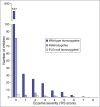Filaggrin haploinsufficiency is highly penetrant and is associated with increased severity of eczema: further delineation of the skin phenotype in a prospective epidemiological study of 792 school children
- PMID: 19681860
- PMCID: PMC2883069
- DOI: 10.1111/j.1365-2133.2009.09339.x
Filaggrin haploinsufficiency is highly penetrant and is associated with increased severity of eczema: further delineation of the skin phenotype in a prospective epidemiological study of 792 school children
Abstract
Background: Null mutations within the filaggrin gene (FLG) cause ichthyosis vulgaris and are associated with atopic eczema. However, the dermatological features of filaggrin haploinsufficiency have not been clearly defined.
Objectives: This study investigated the genotype-phenotype association between detailed skin phenotype and FLG genotype data in a population-based cohort of children.
Methods: Children (n = 792) aged 7-9 years were examined by a dermatologist. Features of ichthyosis vulgaris, atopic eczema and xerosis were recorded and eczema severity graded using the Three Item Severity score. Each child was genotyped for the six most prevalent FLG null mutations (R501X, 2282del4, R2447X, S3247X, 3702delG, 3673delC). Fisher's exact test was used to compare genotype frequencies in phenotype groups; logistic regression analysis was used to estimate odds ratios and penetrance of the FLG null genotype and a permutation test performed to investigate eczema severity in different genotype groups.
Results: Ten children in this cohort had ichthyosis vulgaris, of whom five had mild-moderate eczema. The penetrance of FLG null mutations with respect to flexural eczema was 55.6% in individuals with two mutations, 16.3% in individuals with one mutation and 14.2% in wild-type individuals. Summating skin features known to be associated with FLG null mutations (ichthyosis, keratosis pilaris, palmar hyperlinearity and flexural eczema) showed a penetrance of 100% in children with two FLG mutations, 87.8% in children with one FLG mutation and 46.5% in wild-type individuals (P < 0.0001, Fisher exact test). FLG null mutations were associated with more severe eczema (P = 0.0042) but the mean difference was only 1-2 points in severity score. Three distinct patterns of palmar hyperlinearity were observed and these are reported for the first time.
Conclusions: Filaggrin haploinsufficiency appears to be highly penetrant when all relevant skin features are included in the analysis. FLG null mutations are associated with more severe eczema, but the effect size is small in a population setting.
Figures


References
-
- Candi E, Schmidt R, Melino G. The cornified envelope: a model of cell death in the skin. Nat Rev Mol Cell Biol. 2005;6:328–40. - PubMed
-
- Rawlings AV, Harding CR. Moisturization and skin barrier function. Dermatol Ther. 2004;17(Suppl. 1):43–8. - PubMed
-
- Elias PM, Choi EH. Interactions among stratum corneum defensive functions. Exp Dermatol. 2005;14:719–26. - PubMed
-
- McLoone P, Simics E, Barton A, et al. An action spectrum for the production of cis-urocanic acid in human skin in vivo. J Invest Dermatol. 2005;124:1071–4. - PubMed
Publication types
MeSH terms
Substances
Grants and funding
LinkOut - more resources
Full Text Sources
Medical
Miscellaneous

